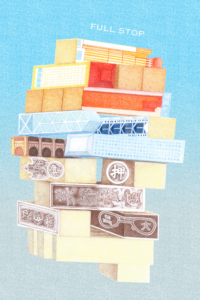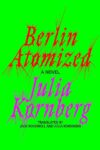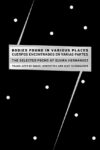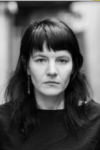On a cold, gray weekend in October of 1974, Georges Perec embarked on a quixotic literary project, one whose modest length and curious application would belie a lasting cultural impression. The resulting work, An Attempt at Exhausting a Place in Paris, sought to reveal the hidden soul of a physical space by means of cataloguing what Perec termed the “infraordinary”: non-events, industrial ephemera, flight patterns of pigeons, bus routes, distant voices, vanishing faces. Over the course of those three overcast days, Perec bounced from café to café, taking inventory of Paris’ Place de Saint-Suplice. His reports sing with the rhythmic life and energetic potential of the famous public square; however, being a document of the infraordinary, they are also necessarily blurred, fractured, even banal. The effect is an oddly touching fever dream of staccato perception, something both airy and dense, playful and serious, trivial and profound. An average entry looks something like this:
The traffic jam has broken up The headlights alone indicate that cars are passing The street lamps progressively light up Way in the distance (hôtel Récamier?) there are now several lit windows An 87 goes by, almost full A man carrying a crate goes by A man carrying a plank goes by A police car goes by, its blue light spinning An empty 87, a full 70, an empty 87 go by People running
It is a passage as pedestrian as it is bizarrely hypnotic. Perec’s words come at us like dispatches from an alien radio and though one can be tempted to skim, to do so means running the risk of missing out on a collection of tersely surreal gems. These moments, awash as they are in an ostensibly empirical reckoning, stand out all the more because of it, pulsing with the charged lucidity of poetry:
Umbrellas sweep into the church Moments of emptiness
Or:
Outside you can barely even make out the faces anymore Colors blend: a grayness that is rarely lit Yellow patches. Reddish glows.
Or my personal favorite:
On the sidewalk, there is a man shaken, but not yet ravaged, by tics
Reading through this humble little volume, I found myself returning often to the idea that these flashes of beauty — of a familiar world poetically refreshed and grown strange before my eyes — were not the planned result of Perec’s technique; rather, they were its byproducts. In chasing after a perceptive totality, Perec’s reality remains perched between the tedious and the transcendent, the chalk outline of a spatial soul. But the outgrowth of his project, found most readily in the concussive shocks of its intermittent beauty, reveals that an attempt toward spatial exhaustion is also an invitation to recontextualize: to discover that, depending on the approach, the familiar is, in fact, contoured, three-dimensional, radically strange. Now, Georges Perec had Place de Saint-Suplice. He had its birds, its buses, its spasms of sound and silence. His space was messily clamorous, radiantly physical.
As for my own familiar spaces and daily haunts — no less teeming with the squawk and bustle of life — we must venture into the abstract, informational space of web experience, wherein I am both myself and the cumulative representational debris of my own data trail. This fact has moved beyond a point of hand-wringing for me, approaching the status of a prerequisite of contemporary culture. Simply put: if social media is a metropolis unto itself, might we fruitfully practice Perecian exhaustion to uncover new meaning, resonance, or even (gulp) beauty? After finishing my reading, I decided to try. But first, which space to explore? Twitter felt too texty, visually anemic; a traditional website, too static and staid. I needed something more manic, fraught with the throb and jitter of an urban street. While not a perfect likeness, I settled on Facebook as the most ripe of my mediated cities, a space where schizophrenic white noise fairly calls out for the promise of a Perecian reinterpretation. Opening a new browser window, I typed in the Facebook URL with steady strokes. As the familiar white-and-blue wall populated before me with pleasingly crisp density, I tried to approach it with wide and freshened eyes. What was there to see? What was I looking for? It’s hard to say exactly. I wanted to shatter the deeply familiar experiential hook, to wreck the weight of expectation and see what infraordinary flotsam might rise in its wake.
For a time, I merely looked and looked, as I imagine Perec did: without apparent aim, disinterested, a floating awareness. The experience was a little like repeating a word until its syllables feel alien upon the tongue, or when as a child I’d stare at myself in the mirror until the reflection became an impossibility. On a whim, I began to scroll — fast enough that barriers and demarcations lost their sense of authority, slow enough that I could read and notice words, singly and in phrases. Again, I felt the shadow of Perec as the faces, posts, and advertisements flew across my vision like the white and green Parisian buses so much a part of his experience. I scrolled and refreshed for over an hour. As expected, much (indeed, most) of what my roving eye captured was nonsensical, a charmless jumble. But what fascinated and excited me were the patterns that revealed themselves and begged to be noticed. Certain sequences seemed to assemble of their own volition, a ouija script of varying import and complexity. Some read like postcards from the absurdists:
Happy Birthday nudes at the arcade
Some read like fridge-magnet poetry after three IPAs:
A final tribute the beast experiences a postmortem
Some were redolent with workaday melancholy:
Sunday night a desert plant
In between these strange assemblages lying somewhere between Burroughsian Cut-Up and involuntary Exquisite Corpse, I found myself apprehending faces — or, rather, features, postures, limbs. I saw green eyes, a wicked smile, coiled biceps, a length of bronzed leg. Divorced from the significance of a body (and the attendant expectations of context), I was free to do what I would with these surreal emblems. They became both less and more than what they were, protean curios ripe for aesthetic appreciation and unconscious play. These bits of buried poetry, the divergent and deeply personal connections I found myself making, ran like a subterranean river beneath the familiar cultural production of the Status Update. It was still Facebook, only newer, richer, stranger.
Wresting novelty from the anaesthetizing routine of social media, even in its admittedly brief and absurd apprehension, felt less like a victory and more like a provocation. Perhaps I had discovered the infraordinary, or perhaps I was merely on its trail. For that one evening, Facebook hung suspended in a bracing inversion. Does that classify as Perecian exhaustion? That seems to me beside the point. In the process of my doomed attempt, I felt that, in some small way, I had honored Perec’s eternal question: “what happens when nothing happens?” After all, what best captures the vital essence of Place de Saint-Suplice? Its rightfully famous church, or a baker’s hat seen through a window? The Fountain of the Four Bishops, or the blinding light off a green bus? And where do we most clearly find the soul of digital experience? In an engagement announcement, or the tangential play of shared symbols? In a filtered photo of a bahn mi, or the literary alchemy of a transcendent mash-up? And then I hear Perec, calling an answer from the café, notebook in hand, eyes on the evening birds: in the end, it might depend on where — and how — you’re looking.
This post may contain affiliate links.








